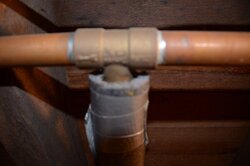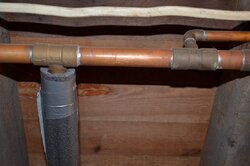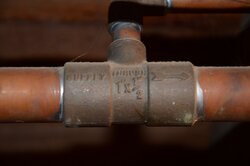Wise Guy,
Those are indeed monoflow tees. The idea being that you have your main artery, and within these tees there is a small "scoop" that diverts some water from the main into the loop. You absolutely need to have the tees with the arrows pointing in the right directions, so that they align with the direction of flow in the main. I am not an expert on Monoflow, but you probably dont want to have a loop feeding off of a loop as you mentioned.
Clarkbug, thanks for the information. This is helpful, and probably was the ingredient for learning what I needed to know for how to fix this problem than other posts. I did a little search on monoflow tees, and discovered some extremely helpful information. I'll share a little of what I discovered. Keep in my mind, as I said at the outset of this discussion, I am no expert when it comes to plumbing/heating.
Apparently, there are a few important rules when using monoflow tees. The installer of this system apparently knew something about monoflow tees, but either forgot other rules or simply ignored them. Here are a few of the rules:
1) Only one tee is needed where the radiator is above the main feed line, and the tee should be installed on the return side of the loop. When the radiator is below the main feed, two tees are required and they should be installed in opposite directions. (In my situation, all the radiators are above the main feed line, and therefore there should only be one tee on each loop. I've noticed that some lines have two tees, as pictured above, some have only one tee, but are apparently installed in the wrong direction, and some loops have no diverter at all. As shown in the kitchen loop picture, the tee is installed on the supply side, not the return side.)
2)the supply tee and return tee should be the same distance apart as the run of radiation. (In my situation, some loops meet this requirement, but most, as shown in the pictures I supplied earlier, the supply and return side of the loop are simply too close to create the proper flow. How to fix this problem will be a challenge.
3) the feed line and loop line should be properly pitched to encourage any air that might be in the system so that it can be released. (In my situation, the line is all over the place, some straight and level, some actually pitched leading away from the bleeder valve. and some lines do have sags, creating pockets whee air pockets can easily hide.)
There are other possible problems with the system here. I am convinced that if I make my system agree with these three simple rules, I am very likely to correct the problem of no heat in the three loops in question. I mentioned earlier that a few years back I cut off one of the loops, the one leading to the laundry room. I've discovered that that may actually create a lack of pressure down the line, and indeed the very next loop is one where I'm having trouble getting heat. So, I'll either have to take those tees out of the line and replace them with a run of pipe, or connect the pipes where I capped them.
At this point I guess I have enough information to get started with fixing the problem(s). Thanks to all of you who took the time to address my concern. I'll let you know how things turn out.




